Jenai Auman's Blog
August 14, 2025
On Being Othered by Bad Theology
After reading and endorsing writer and author ’s forthcoming book, Downsizing: Letting Go of Evangelicalism’s Nonessentials, I was compelled to reach out to her. A regular part of my work is navigating the internet and interacting with others, discussing the intersection of faith and harm; I advocate for loving our neighbors, which includes preventing harm to marginalized and ostracized communities. I often critique the culture of evangelicalism and Reformed movements like the Acts 29 Network and the Gospel Coalition because they harmed me. I also have to acknowledge that I was a part of them. My responsibility includes remembering that those movements both harmed me and malformed me. So, I must learn about the harm I could cause (and already have) by using Scripture in the ways I was discipled and conditioned to. It’s a shock to the system to learn I could be causing harm in the very ways I advocate against. It’s also an invitation to practice humility and engage in the discomforting growth.
 Photo by Ivan Bandura on Unsplash
Photo by Ivan Bandura on UnsplashI reached out to Michelle and asked if she’d be willing to write a guest post for the Othered Substack. I also asked if she’d be willing to help me see how normative antisemitic bias could be in Christianity. I started our ZOOM call by saying “I don’t know what I don’t know, and I need help.” We had a conversation that expanded my perspective and widened my welcome. She helped me further divest of toxic theology, which, as I’m continually learning, is a life-long process.
I think you’ll appreciate Michelle’s words here. I hope you’ll learn from them.
Othered is a reader-supported publication. To receive new posts and support my work, consider becoming a free or paid subscriber.
 On Being Othered By Bad Theology
On Being Othered By Bad TheologyBy Michelle Van Loon
www.michellevanloon.com
“You can fall off a horse from either side.” The woman who spoke these words was an experienced horsewoman as well as a seminary-educated Bible study leader. Her words may have been practical wisdom for a rider, but she spoke them often in the Bible study we co-led to remind us that it was possible to be drawn into theological error by leaning too far in one direction or the other.
I would couple that truism with an additional observation: Theology has consequences. While some may believe that theology is an ivory-tower intellectual pursuit best left to the trained professionals, it has been my experience as a Jewish follower of Jesus that the two dominant streams shaping the Evangelicalism in which I’ve spent most of the last five decades have each had some seismic consequences in real life. What happens in the ivory tower doesn’t stay in the ivory tower. And staying balanced on the horse is a lot harder than it looks.
“Theology has consequences.”
Jewish people comprise about 0.2% of the world’s population, which equates to about 15.8 million souls. Educated estimates suggest that Jewish followers of Jesus worldwide total in the neighborhood of about 350,000–a very small number. One reason it is difficult to get a firm count is because Jewish believers worship in a variety of settings including Messianic, Protestant/Evangelical, and Catholic/Eastern Orthodox congregations. No matter where we worship, the one thing that is true for many of us is that we have experienced friction or estrangement from family and from the broader Jewish community.
The church isn’t always an easy place for a Jewish believer to find a place to belong, in part because of the pull of the theologies on either side of that proverbial horse. On one side of the horse, Dispensationalism, the theology found in pop bestsellers like the 1970’s blockbuster The Late Great Planet Earth and the 1990’s Left Behind series, has influenced everything from Evangelical understanding about how the world works to American foreign policy. On the other side of the horse, Supercessionism, more popularly known as Replacement theology, has a powerful hold on another broad swatch of the Evangelical world.
Both Dispensationalism and Supercessionism have had painful consequences for not only many Jewish followers of Jesus, but have left a negative witness to the wider Jewish community.
At first glance, Dispensationalism seems to be more Israel-friendly, as Israel plays a significant role in its interpretation of how the End of Days will unfold. But under that veneer lurks a deeply troubling set of beliefs. As I wrote in Downsizing: Letting Go of Evangelicalism’s Nonessentials:
The leaders of Neighborhood Church invited a professor from Dallas Theological Seminary to visit the church each year, who unfurled a giant dispensational chart to explain God’s plan for the ages to us. Dispensationalism is a system that describes God’s work in time unfolding in a progressive series of seven historical ages, or “dispensations.” The first four dispensations covered the revelation of God contained in the Old Testament from Adam to Abraham to Moses to David.
Our current age, the fifth in the series, also known as the Church Age, is a pause or parenthesis in the ongoing march toward the end of days. Dispensationalists generally believe that the Church Age began in Acts 2 and will end when all believers will be instantly and supernaturally removed from the earth (the rapture, referenced in 1 Thessalonians 4:16-17).
The first time I laid my eyes on that giant chart, I saw that the Jewish people (also known as “God’s earthly people,” according to the Dispensationalists) faced a grim storyline, while Christians (“God’s heavenly people”) had a much happier one that appeared to include a “Get out of Jail Free” rapture card. I turned to the friend who’d invited me to the church and asked, probably a little too loudly, “As a Jewish believer, exactly where do I fit on that chart?”
She told me I was now in the “Church” category. When I explain to well-meaning gentile Christians that if Adolph Hitler (an antichrist figure if ever there was one!) was rounding up Jews to send them to Auschwitz, he would not care if I confessed that Jesus is my Lord. I’d be in line to the ovens with the rest of my relatives. My faith does not cancel my Jewish identity. It was in that moment, at age nineteen, that I decided I’d better start learning something about theology because the complex yet strangely tidy answers of that dispensational chart left me with lots of questions.
Dispensationalism has impacted my experience as a Jewish follower of Jesus who has worshipped primarily in Evangelical churches. I have heard from my Dispensationalist friends about their undying love for Israel, while at the same time they engage uncritically in sharing antisemitic conspiracy theories that support their hard-right Republican political agenda. This is not new in our current political moment. Antisemitism has been there all along, but certainly the rise of the MAGA movement and its mainstreaming of conspiracy theories has intensified it significantly.
A pendulum swing to the other popular theology in Evangelical circles comes from the Supercessionism at the foundation of Reformed and neo-Reformed theology. This theological point of view, which states that the church has replaced disobedient Israel as the recipient of God’s covenantal promises, has existed in some form since the days of the primitive church. However, it became foundational to Reformation-era Protestantism, particularly in Lutheran and Calvinist streams. The Neo-Reformed movement, which includes Evangelical lightning rods like John MacArthur, Mark Driscoll, and John Piper, as well as the Acts 29 network of churches and the parachurch organization The Gospel Coalition all espouse Replacement theology.
A few years ago, I wrote about some of my issues with Supercessionism in a blog post:
Though it is true that the big C Church is now participating in the mission of proclamation first given to Israel, she does so because she has been grafted into Israel (Rom. 11:17-20), not because God took a chainsaw and stump grinder in order to eradicate Israel from His eternal plans. Replacement theology has long fed anti-Semitic sentiment and is no friend of the Jewish people...Replacement theology taken to a demonic extreme fueled some of the ideology that allowed Nazism to flourish.
This theology has fueled antisemitism from the Crusades to the pogroms to the concentration camps, as well as everything in between. It is at the heart of some of the conspiracy theories fueling the huge spike in antisemitism around the world today.
Dispensationalism has objectified me. Replacement theology has erased me. To borrow Jenai’s apt book title, both camps have othered me.
I am not without hope, though it can be tiring to be in the often-lonely role of encouraging my Gentile siblings in faith to stay on the horse. Most congregants and more than a few church leaders never think through the implications of the theology into which they are born (or born again). Many would never think of themselves as antisemitic, or believe they are teaching hard-core Dispensationalism or Supercessionism until I highlight that they might be teaching one of these things without ever saying the theological words or busting out a chart. Here are some examples:
Speaking as though the God of the Old Testament had a different, much angrier personality than the God of the New Testament
Speaking about the Law as though it is completely irrelevant
Insisting the Old Testament is just for the Jews
Insisting that only the Ten Commandments are relevant–and suggesting really that only nine of the ten are binding on Christians’ lives today. (The one about keeping the Sabbath? Maybe not so much.)
Using the Old Testament in sermons only anecdotally if at all, rather than teaching or preaching from it on its own merits
Calling the Old Testament “legalistic”
Treating the Old Testament, particularly the book of Genesis, as a tool to be used in apologetics debates
Claiming that all the promises God made to the Jewish people in the Old Testament now belong to the Church
Praying promises (such as the trusty graduation card favorite, Jeremiah 29:11) completely out of context, and using them as though they were intended for an individual
Speaking about the Law as though it is the enemy
Using the Pharisees to represent the Old Testament, insisting that the way Jesus spoke to and about them “proves” his feelings about the Law
Preaching or teaching from the New Testament as if it exists in a vacuum, rather than recognizing that as much as a third of its texts directly reference the Old Testament
Ignoring the fact that Jesus is Jewish, and that “Christ” is not his last name but his title, connected to hundreds of Messianic prophecies in the Old Testament
The first Jewish apostle to the Gentiles, Paul, wanted those to whom he was ministering to get this right for their own sakes as well as for the sake of his own people. He wrote, “Inasmuch as I am the apostle to the Gentiles, I take pride in my ministry in the hope that I may somehow arouse my own people to envy and save some of them.” (Romans 11:13-14). A commitment to stay on that horse can begin to heal what a whole lot of bad theology and worse practice have wrought.

 michellevanloon.com
michellevanloon.comMichelle Van Loon’s writing is shaped by her deeply rooted faith in Christ, secular Jewish heritage, spiritual hunger, and storyteller’s sensibilities. She has been a regular contributor to Christianity Today and In Touch Magazine. Her books include Becoming Sage: Cultivating Meaning, Purpose, and Spirituality in Midlife; Moments and Days: How Our Holy Celebrations Shape Our Faith; and If Only: Letting Go of Regret, which won an award of merit in the 2015 Christianity Today Book of the Year awards. You can read more from Michelle at michellevanloon.substack.com.
Tap that heart icon 🖤 for me. Even better, leave a comment. Tell me about what you appreciate about the OTHERED Substack and what you hope to read in the future. Give me an idea I can research and hyperfixate on!
Your engagement sends a signal to the Substack powers that be, letting them know my posts may be helpful to others.
August 7, 2025
Honoring Limitations & Facing Forward
I’ve been missing-in-action as far engaging on social media and the internet the last few months. To be candid, I wasn’t very present on the internet in the earliest parts of 2025 either. Between my own work load, inching closer toward completing my seminary program, partnering with different organizations, and everything (gestures widely) happening in the United States, my plate has been full. But I am also exactly where I need to be. I’m full with the sort of work that I want to be doing. And that’s a pretty cool feeling.

Between doing the good things I like and navigating the horrible things happening in our world, I could feel burnout’s maw about to bite.
I needed a breather. So, I took one during the summer. Now, I’m glad to show up here, tell you more about what’s been going on, and what is to come.
Othered is a reader-supported publication. To receive new posts and support my work, consider becoming a free or paid subscriber.
New WritingThis is an overdue update!
Early in the year, I had a writer and editor I’ve previously worked with reach out and ask if I wanted to write a piece for a Christian publication in Canada—Christian Courier. The editor wrote to me about how folks in Canada are wondering what the heck is going on in the United States and why Christians aren’t fighting the authoritarian takeover happening with the White House. She asked me to write a piece for their Canadian readership, and I did.
“Living maladjusted in the United States” published with Christian Courier in June. In fact, it was the feature piece in their print edition. I received my print copy in the mail in early June. They published the piece online as well, and I’m glad to share it with you!
 “Living maladjusted in the United States”And also 👀
“Living maladjusted in the United States”And also 👀 I’m teaching/educating/facilitating/co-facilitating with a couple of nonprofit organizations this fall semester! 💃
madeforpax A post shared by @madeforpax
A post shared by @madeforpaxThis is my second year facilitating the Contemplative Activism and Spiritual Formation cohort with the PAX Fellowship. In fact, the Contemplative Activism and Spiritual Formation cohort last year had so much engagement that they created two cohorts this year so that there would be more room. I will be hanging with the PAX fellows in Cohort A while the wise Josúe Perea will be hanging with the PAX fellows in Cohort B.
Enrollment is closed for 2025-2026, but if you’re interested in potentially joining any cohort for 2026-2027, you can join the waitlist for first dibs.
I am also co-facilitating a group navigating power dynamics with the Reclamation Collective!
reclamationcollective A post shared by @reclamationcollective
A post shared by @reclamationcollectiveI joined the board of the Reclamation Collective (RC) in January of 2025. The RC is a nonprofit oriented on mental health, and it exists to resource survivors and offer non-clinical interventions that facilitate healing. We also exist to bring more awareness to the reality of religious trauma and spiritual abuse, not only in Christian spaces but in all spaces where spirituality plays a role.
If you are a faith leader, therapist, spiritual director, or a person who holds sacred, healing space for others in any way, I encourage you to consider joining the Spiritual Power Inventory Processing Group.
Topics we will discuss include “trust as power”, boundaries, communicating roles, consent and more. You can find more information and enroll on the Reclamation Collective website.
RC has held this group before, but this is the first time it will be co-facilitated by 1) a licensed mental health professional (Kayla Felten) and 2) a spiritual director/person of faith (myself). Sometimes it is hard to integrate mental health language and theological language. Kayla and I are hoping to facilitate that sort of integration in the Spiritual Power Inventory group.
Enrollment ends Sept 12.
(For those who envisioning participating in one or both of the above, scholarships are available.)
 New Things to Come
New Things to ComeI’m also going to be featuring some writing from peers on Substack. I have a piece by writer and author coming up next. She’ll write on othering and otherness from the Jewish Christian perspective and how easily Christian theology can become antisemitic. I reached out to Michelle because I trust her but also because I was woefully uneducated on how entrenched antisemitism has been in Christianity. I’ve learned from Michelle and will continue to do so, but I also extended an invitation for her to write so that you could learn from her as well.
Stay tuned for that in the coming weeks. And keep an eye out for Michelle’s newest book publishing August 19th, Downsizing: Letting Go of Evangelicalism’s Nonessentials.
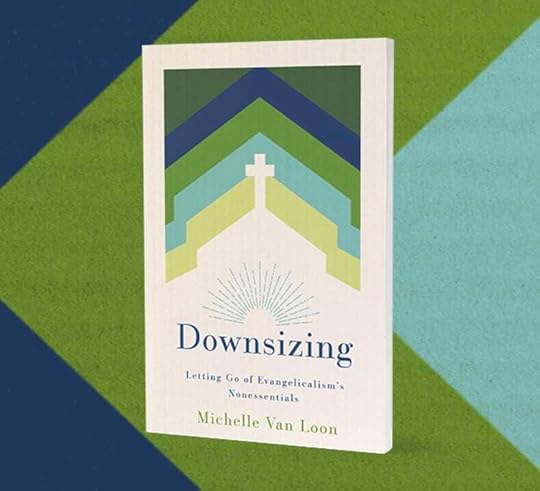
Until then, I hope you and yours have had a restful summer.
May the bite of burnout be ever far from you, but may the embrace of peace envelop you.
I’m with you and for you.


Tap that heart icon 🖤 for me. Even better, leave a comment. Tell me about what you appreciate about the OTHERED Substack and what you hope to read in the future. Give me an idea I can research and hyperfixate on!
Your engagement sends a signal to the Substack powers that be, letting them know my posts may be helpful to others.
April 17, 2025
What Does It Mean to Weaponize a Word?

 Photo by Nick Fewings on Unsplash
Photo by Nick Fewings on UnsplashI received a text from a friend, telling me about someone I went no-contact with years ago. We’ll call her No-Contact Nina. Deciding to go no-contact with Nina came after a persistent pattern of bullying, borderline abusive behavior. While I categorized it as bullying and told others it was perpetuated by Nina, some folks still interpreted the tension as relational beef between two parties. As I had shared friends with Nina, I told a few of them, “I don’t expect you to choose sides. I’m not asking you to pick me over her. I’m not here to police friendships, but I do hope you respect the fact that I keep her at a distance. And I’ll ask you to see her bullying for what it is if and when the time comes.”
I was articulating my boundaries. And sure enough, the time came.

The friend who originally messaged me shared that he received communication from Nina pertaining to his friendship with me. Nina told him she had “boundaries.” Because of Nina’s boundaries, this mutual friend could no longer be friends with her if he was friends with me. The implicit, unspoken message was that Nina’s boundaries required my friend to change behaviors. 😬
I put my head in my hands, and texted my friend back. 🤦♀️
💬 “That’s not how boundaries work.”1
Othered is a reader-supported publication. To receive new posts and support my work, consider becoming a free or paid subscriber.
How to Weaponize a WordThis exchange with my friend (spoiler alert: he’s still my friend) happened in summer of 2024. However, an incredibly similar but more public situation was in the news a year prior. In July 2023, Sarah Brady, an ex-girlfriend of actor Jonah Hill, posted screenshots of text messages between herself and Hill to her Instagram Stories. The screenshots show a conversation where Hill gave Brady a list of expectations, including behaviors SHE needed to change, because of HIS “boundaries” for their romantic partnership.
Because it bears repeating: controlling the actions of others and calling it “boundaries” is not how boundaries work.
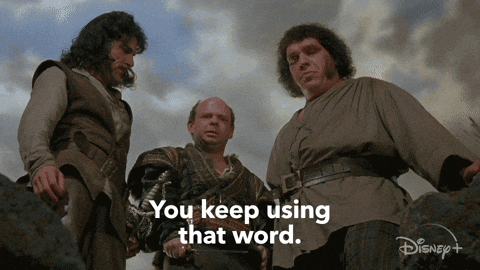
Writer Aditi Shrikant with CNBC wrote about the exchange between Brady and Hill and had Denver therapist Lisa Marie Bobby weigh in. Bobby noted that “boundaries are about your own actions, not someone else’s.” She also mentions that weaponized therapy speak happens when “people take ideas that look, feel, and sometimes sound quite virtuous and healthy, but then use them in ways that effectively control or harm other people and relationships.” Ultimately, Bobby says that this sort of weaponization is misappropriation of an idea that efficiently shuts down conversation.2
Bobby’s mention of shutting down a conversation reminded me of Amanda Montell’s 2021 book Cultish wherein she describes how cults and cultish communities use thought-terminating clichés. Thought-terminating clichés within Christianity are something I’ve written on previously. You can check that out here. ⬇️
Thought-terminating clichés (TTC) weaponize language to shift power dynamics. They use words to manipulate another person’s (or the public’s) perception so that the perpetrator can abscond accountability and relational responsibility. A TTC makes it seem like there is a clear right and wrong. Challenging the TTC makes others perceive the dissenter is in the wrong. The risk of dissent is ostracism by the group.
So, potential dissenters often choose not to dissent. Because of this, TTCs and weaponized words are incredibly effective. Manipulative folks know this.
Regarding Brady and Hill, Brady could have pushed back in the moment against Hill’s suggestions to communicate something like, “You can’t control what I post.” However, Hill had already founded his argument on the value and virtue of boundaries. Thus, the implicit (and manipulative) message communicates, “If you don’t do what I say, you’re crossing my boundaries.”3
Again, this is not how boundaries works, BUT this is how weaponizing the word “boundaries” works.
Implicit & Explicit CommunicationWhat we communicate and how we receive communication is usually a combination of explicit and implicit communication. There are the words explicitly spoken and then there is evidence of the implicit beliefs revealed through behavior and body language. (A lot of folks familiar with anti-racism work know that folks are often more attuned to explicit racism, but they have to learn more about the nuances of racism to understand implicit racism.)
When explicit and implicit messaging communicate the same thing, there is alignment, congruence, or integration. Alternatively, when explicit and implicit communication run counter to each other, they create cognitive dissonance.4 When cognitive dissonances exists, a person receiving dissonant communication questions their own perception. This is a precursor to “gaslighting.”5
The rub? Intentional misalignment in explicit and implicit messaging works in a manipulative person’s favor.
 “The Art and Science of Manipulative Language”
“The Art and Science of Manipulative Language”In her journal article “The Art and Science of Manipulative Language,” linguist Viviana Masia writes that implicit communication occurs “whenever some content of a message … is left unexpressed or underspecified.”6 Masia studies how the human brain works in understanding communication. Our brains are conditioned to process information in different ways when it comes to explicit and implicit types of messaging. Masia shares that when communication is explicit—when a communicator plainly states what they mean—the receiver’s brain works harder as they evaluate for validity.
BUT! When communication is implicit, the brain works less by taking cognitive short-cuts to do some of the interpretative work that the communicator did not do. This makes the receiver a co-participant in the interpretative choices of implicit communication.7
Roping you into ownership of the interpretation is how manipulative communicators leverage implicit messaging. When you have part “ownership” in the interpretation of THEIR implied messaging, you are less likely to challenge their assertions.
What Can We Do?Therapy speak words aren’t the only words that can be weaponized. Words that implicitly include value statements are effective when leveraged for deception. If you’re an OG reader of mine, familiar with my story of spiritual abuse or if you’ve experienced spiritual abuse yourself, you may have your own list of Christian words that have been weaponized. (I also mention a few of these in my Thought-Terminating Clichés Substack Post but also in Othered.)
The problem is communication is a human need. We need to be able to communicate with one another. Words are a pragmatic part of societies and cultures, but they are also wells of creativity. They can cut us or cure what ails us.8 Weaponized words disrupt the beauty of relationships, the beauty of words, and our relationships to certain words.
We can do something. We can grow in our discernment, and when we sense something isn’t right, we can say something. Many folks understandably ask, “How can I grow in discernment?” I could give you prescriptions to follow: Ask better questions. Ask more questions. Pay attention to power dynamics. Look for both explicit and implicit forms of communication.
But strengthening your discernment and even employing some of these suggestions requires more spiritual formation work.
With many of the folks I work with in spiritual direction, to become more discerning requires that you be more intentional about who you are becoming. In other words, you want to be discerning, but what values guide your discerning process? Where are your ethical boundaries? Do you have ethical boundaries? Have you named them for yourself? At their core, narcissists are discerning; they learn, scan, and research people so they can effectively lovebomb and entrap others in dependent relationships. Narcissists are discerning so they can exploit.
Holistic folks do not exploit others. In fact, they are intentional about dismantling exploitative practices and systems, including the systems of language. Holistic people ask questions not to capitalize on a topic or leverage their relationships with folks. Holistically formed people ask questions so they can be a part of building a better world. Holistic people ask questions so they can identify the people and methods which break our world.
What are the problems you see in the world? What do you believe the solutions might be? These are worldview-building, identity-forming questions. Knowing who are you and having dreams about the sort of person you’re becoming is the foundation for becoming a more holistically discerning person. When you become more secure in who you are, your internal stability helps you discern when people, perception, or words are being manipulated and weaponized. That internal stability may help you find the boldness to speak when it’s time to say something.

I clocked what No-contact Nina tried to do when I received my friend’s text. She used “boundaries” as a thought-terminating cliché to 1.) remain unchallenged, 2.) continue her abusive bullying to isolate me, and 3.) try to manipulate my friend’s actions. Thankfully, I trust my friend and his discernment. He’s an expansive, holistic person. And he clocked Nina’s toxicity, too.
Expansive people—people who don’t exploit others—these folk exist. We can be these people. And I believe each of us can pull tremendous wisdom from the well of our lived experiences to find one another so that we really can build a better world.
With you and for you,

UPDATE: An earlier version of this Substack had Masia’s article improperly linked. This current version has the correct link to the American Scientist article.

Hi! I mentioned spiritual direction above. I do have very limited available for spiritual directees. If you’re interested 👀 , click here: ⬇️
Also, if you made it to the end! Tap that heart icon 🖤 for me. Even better, leave a comment. Tell me about how different words have been weaponized in your life.
Your engagement sends a signal to the Substack powers that be, letting them know my posts may be helpful to others.
Have you read Othered? If so, an Amazon Review would go a long way in supporting me as a writer. Email me a link of your review or a screenshot of your rating, and I’d love to gift you a lifetime subscription to my *paid* Substack.
1The story about my friend and Nina is shared with my friend’s permission. He read and approved the above prior to publication. Nina is probably reading this. I did not cross my boundaries to seek her permission. In the words of Anne Lamott, “If people wanted you to write warmly about them, they should have behaved better.” Leave me alone, Nina. You know who you are.
2You can find more on weaponized therapy speak at https://www.mindbodygreen.com/articles/how-to-use-therapy-speak.
3I don’t have room to explore this here, but weaponized speak is an effective way to employ DARVO (Deny, Attack, Reverse the roles of Victim & Offender). Weaponized speak incapacitates a victim, leaving them without an option to advocate for themselves because doing so would make them look like the conflict’s offender.
4You can read more about cognitive dissonance from the man who coined the phrase JSTOR. You can create a free JSTOR account if you don’t otherwise have access. You can read up to 100 free JSTOR articles every so many days, which is awesome.
5Read peer-reviewed research on gaslighting at https://journals.sagepub.com/doi/abs/...
6Viviana Masia, “The Art and Science of Manipulative Language.,” American Scientist 110, no. 5 (2022): 300-305. https://doi.org/10.1511/2022.110.5.300.
7I encourage you to read Masia's article in full. It is a wellspring of information.
8If you read Othered, you’ll also see that I wrote something similar there.
March 26, 2025
People's Car, Power, & Patterns

Content warning: Post includes references to Nazi history & Adolf Hitler.
Update: For those who appreciated my last Substack post on the pettiness of Michelangelo, I have an udpate for you, too.
 Photo by Karol Smoczynski on Unsplash
Photo by Karol Smoczynski on UnsplashThe Volkswagen Beetle became the car of the countercultural movement of the 1960s. It was so popular, it garnered its own film franchise, with the Beetle featured as the title character of Herbie: The Love Bug. And as fun and whimsical as the Beetle looks, its origins are much darker.
In 1938, amid the fanfare of the Berlin Auto Show, Adolf Hilter introduced the German people to a small family vehicle. Cars at the time were typically accessible to those of wealth and means. But Hitler and his underling, Robert Ley, were focused on a movement known as Kraft durch Freude (KdF) which translates to “Strength through Joy.” KdF was an effort to make leisure activities available to all German people. Folks in the KdF built resorts and cruise ships so that the regular German worker and their families could enjoy activities that were previously limited to the bourgeoisie.
Another effort of the KdF? The Kraft durch Freude-Wagen. KdF leadership realized they had reached the limit of their original promises. The Volksgemeinschaft or “the People’s Community” were so interested in vacations, they overwhelmed the railways while en route to their holidays.1 So, the KdF pivoted and made another promise—a car for the people. Hitler commissioned the design of the KdF-Wagen by enlisting the services of engineering genuis, Dr. Ferdinand Porsche. Porsche was producing prototypes in his garage for Hitler while the Volkswagenwerk, “the People’s Car Factory,” was being built in Saxony.
 The prototype of Porsche’s original design; Image from Toyota Automobile Archives; https://toyota-automobile-museum.jp/e...
The prototype of Porsche’s original design; Image from Toyota Automobile Archives; https://toyota-automobile-museum.jp/e...Once the prototypes were created, KdF leadership began exhibiting the car. They continued to make promises of accessibility. The cost of the KdF-Wagen would be 9,900 Reichsmarks. The average German family earned about 32 marks a week at the time. So, the KdF created a savings card families could fill with stamps. If families sent 5 marks a week to the KdF, they received a stamp for their card book. If, however, they missed sending 5 marks just one week, their savings card became forfeit. Once the card was full, the family was to receive their very own car.2
The problem? Volkswagenwerk held a few prototypes, but they never made the cars. The marks German families sent weren’t used to create their promised vehicle. Every single mark was used to fund the manufacturing of the war machines used by the Third Reich and Nazi Party. Even the design for the KdF-Wagen was used to design other war vehicles such as the Kugelwagen (an all-terrain vehicle) and Schwimmwagen (an amphibious vehicle).3
Were the people ever going to receive the cars promised? No.4 The KdF and all leisure activities were a part of a mass effort to keep German workers happy and to quiet dissent among laborers who began embracing Marxism. The KdF existed to socially groom the German people into accepting their subjugation under Reich leadership. KdF activities kept German men healthy so they could serve as soldiers in the war to come.5
The “Strength through Joy” movement and the creation of a “People’s Car” was the Third Reich’s way of exploiting their own people. 6
Oppressors First Invade Their OwnIn Captain America: The First Avenger, Dr. Abraham Erskine has a memorable line: “People often forget the first country the Nazi’s invaded was their own.”7 To Dr. Erskine’s point, the KdF organization began in 1933. German leadership reintroduced conscription in 1935, openly rejecting the military restrictions instituted in the 1919 Treaty of Versailles. The unveiling of the KdF-Wagen was on May 26, 1938. On September 1, 1939, many German men found themselves invading Poland, the irony being that their invasion was partially funded with their own money.
 René Magritte, "Those who cannot remember the past are condemned to repeat it."--George Santayana, The Life of Reason, 1905. From the series Great Ideas of Western Man., ca. 1962, gouache and pencil on paper mounted on paperboard, sheet: 13 3/8 x 9 1/2 in. (34.0 x 24.2 cm), Smithsonian American Art Museum, Gift of Container Corporation of America, 1984.124.194
René Magritte, "Those who cannot remember the past are condemned to repeat it."--George Santayana, The Life of Reason, 1905. From the series Great Ideas of Western Man., ca. 1962, gouache and pencil on paper mounted on paperboard, sheet: 13 3/8 x 9 1/2 in. (34.0 x 24.2 cm), Smithsonian American Art Museum, Gift of Container Corporation of America, 1984.124.194The aphorism goes, “Those who cannot remember the past are condemned to repeat it.”8 Many saw the news coverage from March 11, 2025 with DJT hawking Tesla’s wares on the South Lawn of the White House. Tesla stock had plummeted more than 40% since the start of 2025; DJT showed his support buy purchasing a red Tesla Model S. Since the start of the campaign leading up to the 2024 presidential election, folks have witnessed and written on the connections between Nazi Germany and MAGA U.S.A. More folks are reading and studying history so that we are not condemned to repeat the sorrows of the past. Because of this, we tend to know propaganda when we see it.
Since March 11, others began sharing thoughts online, making the connection between the KdF-Wagen announcement and the White House Tesla event. You can see the use of symbolism in propaganda between the photos from 1938 and March 11, 2025. (The licensing fees required to post these photos are beyond my means. To make a visual available for this post, I’ve done my own sketches based on the photos. You can also view the side-by-side first compared on BuzzFeed.)
The prominent symbol for the 1938 image is the Nazi swastika,9 which the Nazi Party appropriated from other cultures. If you zoom in on the original image, you’ll see the swastika featured on the podium, on flags, as decoration in the background, and, lastly, the massive swastika featured inside the cogwheel shape.
The prominent symbol for the Tesla event? The White House itself—one of the most recognizable buildings in the world. And while I was never a political science or communications major, I’m not naïve enough to believe DJT’s suit, tie, and the color of the Tesla are coincidental. Red, white, and blue are effective symbolic choices.
 Sketches by Jenai Auman; use prohibited.
Sketches by Jenai Auman; use prohibited.The Tesla shilling on the South Lawn—both the reason for it and the receptivity to it—is different from the unveiling of the KdF-Wagen in 1938. The similarities in both stories are found in the potential hope via promises made and the power of the people in their voting dollars. In both instances, the people were being pandered to—sold an idea of greatness. Hitler promised a vehicle that would be made accessible to the People’s Community (Volksgemeinschaft). Promises of upward mobility are tempting. So, the German people sent 5 marks every week to fill their savings card. Musk promised double vehicle output over the next two years. Promises of increased capital gains are alluring. Incidentally, Tesla stock did rise after the March 11th event.
The question to ask now isn’t so much, “Is DJT pandering to the people and using Musk’s Tesla to do it?” He absolutely is.
What We the People should be asking ourselves is, “How is our government socially grooming us into accepting a new empire?”
Being MaladjustedOn June 4, 1957, Rev. Dr. Martin Luther King Jr. gave an address at the University of California at Berkeley which was later published in 1958. Titled “The Power of Nonviolence,” King ends with an encouragement to be “maladjusted.” He mentions that modern psychology would say that a maladjusted individual is one who is ill-equipped to navigate life in a healthy way. But King offers an alternate definition:
“[T]here are some things within our social order to which I am proud to be maladjusted and to which I call upon you to be maladjusted. I never intend to adjust myself to segregation and discrimination. I never intend to adjust myself to mob rule. I never intend to adjust myself to the tragic effects of the methods of physical violence and to tragic militarism. I call upon you to be maladjusted to such things… As maladjusted as Jesus of Nazareth who dreamed a dream of the fatherhood of God and the brotherhood of man. God grant that we will be so maladjusted that we will be able to to go out and change our world and our civilization.”10
- Rev. Dr. Martin Luther King Jr. (1957)
So often, when leaders have used and abused their power to dismiss, hurt, and harm people, the leader’s “community,” followers, or fanatics default to the perspective of the leader. They may say, “We need to give him grace; leading people is a hard job.” This is the behavioral conditioning doing it’s work. The temptation of power is that a leader can leverage a “community”, even a “new” Volksgemeinschaft, to slowly condition folks to adjust to a new normal—to become foot soldiers, ready to carry out the mission and defend said leader, even when the leader been credibly accused of misconduct. This may resonate with folks paying attention to the fallout since the release of the report on The New Evangelicals on March 16. Adjustment to toxic systems is the fruit of empire that grows within us.
Many folks use Jesus’s name as a symbol for a new empire. They speak Jesus’s name, not as a delight, but as decoration for pyramids. We can make discerned distinctions when we pay attention to the story Jesus lives. He doesn’t repeat the pattern of the empire. He divests. When Jesus extended grace, it wasn’t to the empire or to the emperor. He extended grace to those whom the empire had chewed up and spat out.
In the words of Jesus, “Go and do likewise” (Luke 10:37b, NRSV). Extend grace to those on the margins. Divest of white Christian nationalism. Divest of white supremacy.
Be maladjusted to the empires of the world. Be discerning of the patterns of history. Dissent to being socially groomed by propaganda. Embrace the power of nonviolence. Love your neighbors and your enemies.
Be so maladjusted that you just might be a part of changing the world. Get weird with it.

Othered is a reader-supported publication. To receive new posts and support my work, consider becoming a free or paid subscriber.
ExtrasFirst, kudos:I have my engineer husband, Tyler, to thank for teaching me the history of the Beetle. A fan of British host and commentator James May, Tyler learns plenty about engineering history. I inevitably learn by proximity. This lesson stuck with me such that it came to mind when I saw the images from the White House lawn on March 11th.
I linked the original Cars of the People episode in the footnotes. It is where Tyler and I first learned of the history of the Volkswagen Beetle. It’s worth your time.
Second, for appreciators of my recent post on Michelangelo:To jog your memory, I wrote about Michelangelo painting a nemesis of his in “hell” while finishing his second Sistine Chapel fresco The Last Judgment. If you read my post, “God Bless Good Pettiness,” (linked below), you’ll know exactly where this nemesis is in the fresco. 😏
Imaged below is DJT and Melania visiting the Sistine Chapel in May of 2017. Our friend Biagio de Cesena as Minos, host who ushers folks into hell, is just right of DJT’s right shoulder. 🙃
 Photo by History in HD on UnsplashLastly, Shirt Donation Update:
Photo by History in HD on UnsplashLastly, Shirt Donation Update:I announced in a former post (linked below) that I had created a “Courageous Women” shirt. I mentioned that the profit from the sales of said shirts would be donated.
Thanks to those who ordered, I raised $54.52 in profit in February 2025. My original plan was to donate to a nonprofit as I’m connected and work with quite a few who resources survivors or marginalized folks. However, while waiting for the payout transfer, I learned of a single mother leaving a domestically abusive situation. She was having to start from scratch in furnishing a new home for herself and her children.
I donated the proceeds of February 2025 shirt sales personally to her on March 3.
The plan is to continue donating any and all shirt proceeds, so if you have your eye on one 👀 :
If this post was helpful, considering tapping the heart 🖤 icon & leaving a comment. Your engagement helps me reach more people who may appreciate a word on history, holistic spiritual formation, and being maladjusted. Encourage your friends to subscribe if you think the words here might be fun or helpful to them.
You can find past posts from Othered by visiting jenaiauman.substack.com.
Have questions? Leave a Comment! (Click on that comment bubble at the bottom of the email!
1Hasso Spode, “Fordism, Mass Tourism and the Third Reich: The ‘Strength through Joy’ Seaside Resort as an Index Fossil.” Journal of Social History 38, no. 1 (2004): 132.
2Tom Whitter dir. "Episode #1.1," James May’s Cars of the People , season 1, episode 1. Aired August 10, 2014, on BBC, 09:19.
3Tom Whitter dir. “Episode #1.1”, 11:39.
4After WWII, Volkwagenwerk was turned over to the people of Saxony and there was an effort to compensate those who sent marks for a car. Watch the Cars of the People episode mentioned for more details.
56I mention this is often a theme of toxic organization and communities, exploitation of the community itself, in Othered. I think it’s worth your time.
7Captain America: The First Avenger, 24:57.
8George Santayana, The Life of Reason: Introduction and Reason in Common Sense, PDF (1905) 172. *I’m quoting a well-known aphorism, but to clarify, I do not hold the same views as Santayana. He was known to view eugenics positively and, as a philosophical naturalist, he didn’t believe interracial marriage was a benefit to society.
9I wasn’t certain I wanted to draw the swastika in my sketches, so I used a repeating line pattern that followed the line direction and shape of the swastika.
10Martin Luther King Jr. “The Power of Nonviolence”, in I Have a Dream: Writing and Speeches that Changed the World, ed. James M. Washington (New York: HarperOne, 1992), 33.
March 12, 2025
God Bless Good Pettiness
 Photo by Calvin Craig on Unsplash
Photo by Calvin Craig on UnsplashThis is a story of art, pettiness, subversion, and wit, and it all hails from the life of Michelangelo.
Othered is a reader-supported publication. To receive new posts and support my work, consider becoming a free or paid subscriber.
Michelangelo famously painted the Sistine Chapel.

What many people don’t know is that Michelangelo didn’t want to paint the Sistine Chapel. He didn’t consider himself a painter. He identified as a sculptor, but when multiple popes asks you to paint the Sistine Chapel, what are you gonna do?
He was commissioned to paint the Sistine Chapel twice. The first time he was reluctantly commissioned by Pope Julius II. There’s some speculation that Julius wanted to sabotage Michelangelo (a story for another day). But Michelangelo completed his fresco on the ceiling between 1508 and 1512. He was then commissioned the second time (reluctant again) decades later by Pope Clement VII (finished and overseen under Pope Paul III), painting the west wall from 1536 to 1541. Our story concerns the latter fresco titled The Last Judgment.
Like other art of this time period, nudity was normal and increasingly so since the emergence of the Renaissance. Michelangelo himself was known for nude artistic work, having sculpted his statue David from 1501 to 1504. Thus, it isn’t surprising that Michelangelo included nude figures in his frescoes. The story goes that there was a “master of ceremonies” named Biagio Martinelli (or Biagio da Cesena) who came with Pope Paul III to view Michelangelo’s progress with The Last Judgment. Biagio saw the nude figures and scoffed, saying that Michelangelo’s work was not becoming of a place of honor. The fresco was painted on the wall behind the altar. Biagio’s point was that, when gazing at the altar, communicants and others would be viewing so much genitalia. So, Biagio told the Pope, God, and everyone that Michelangelo’s work was dishonorable, more befitting for a brothel.1
This is when I imagine Michelangelo felt a little petty. He took offense with Biagio’s comment. Remember: Michelangelo is a master who preferred sculpting. He reluctantly left his home in Florence to accept these commissions. And in the middle of his work, Biagio, a master of ceremonies, was dunking on Mike’s work. So, Michelangelo created his own 16th-century diss track. 👀
The Last Judgment is a bit chaotic. There’s a lot going—lots of folks being judged. Christ, the Apostles, and other important folks are centered at the top. You’ll see even St. Bartholomew (or Nathanael) holding his own “flayed skin.” (You should zoom in on the image below. It’s wild.) For our story, though, focus on the bottom right of the painting. Here you can see a figure in a boat.
This figure is supposedly Charon of Greek mythology pulling double-duty in the ultimate Christianity crossover. He’s painted ferrying souls to the gates of hell. Satan, though, isn’t the one to receive the souls. Nay nay. Instead, it is the character of Minos who Dante writes about in the Divine Comedy.
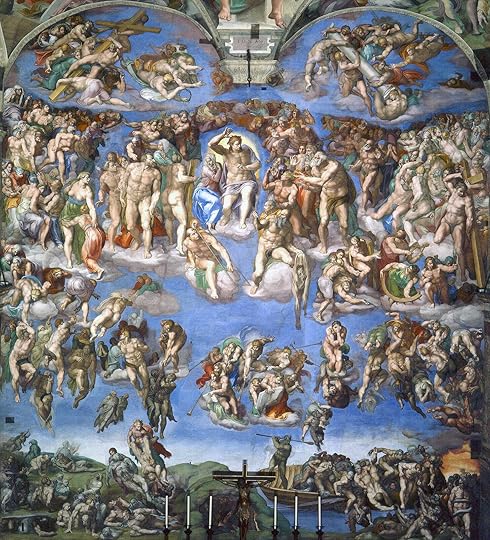 By Michelangelo - See below., Public Domain, https://commons.wikimedia.org/w/index...
By Michelangelo - See below., Public Domain, https://commons.wikimedia.org/w/index...In the Divine Comedy, Minos received the souls of the damned, weighed them, and judged which circle of hell they would live in for eternity by wrapping his tail around them. If the tail circled around a soul, say, seven times, they would live in the seventh circle of hell.2 Minos is the figure with donkey ears at the most bottom right of the fresco (enlarged below). In an ironic twist, this visualization of Minos has his own tail wrapped around himself. To go further, Minos’s tail is also a snake 🐍 , and the snake is biting Minos’s own genitalia. 😬

Why does this make Michelangelo petty? 👀 Well …
Michelangelo used Biagio’s likeness to paint Minos’s profile. Mike painted Biagio in hell. Biagio, as Minos, is visualized with donkey ears—a sign of ignorance. As Minos, Biagio has judged himself by wrapping his tail around himself twice. This corresponds with the second circle of hell; in Dante’s Inferno, the second circle represents the sin of lust. Biagio made comments about nudity in Michelangelo’s paintings. So, Michelangelo was going to paint his commentary on how he interpreted Biagio’s adamance for hiding nudity in art. “Obsessed much? Maybe you’re lustful.” And because Biagio complained about nudity during the preview, Michelangelo exercised another chance to be petty. Does Michelangelo paint Biagio’s bits and bobs in the fresco for all to see? No. Mike hid Biagio’s bits via snake bite.
The LAYERS! Petty level, expert. 💅

That’s not all. Biagio, complainer he was, did complain to Pope Paul III. He asked Pope Paul III to have his likeness removed from the painting. Pope Paul III supposedly had a bit of a laugh and said “if Angelo had put [Biagio] into Purgatorie, [the Pope] then had power in himself to have released [Biagio] thence, but being it was into hell, it was beyond [the Pope’s] jurisdiction.”3
Maybe Pope Paul III was a little petty, too.4 💅
The chef’s kiss? If you Google “Biagio de Cesena” today (484 years after the fresco was completed), you immediately get this story and find image after image of Biagio as Minos. We love. 🫶
Art as DissentLike many of you, I’m thinking through my own work and the direction of my activism for the next several years. Like Michelangelo, I am also somewhat of a gig-worker. I make pitches, take commissions, fill out my W9s, report 1099s, and collaborate with folks throughout each year. When I often collaborate with others, they’ll request I send over a short bio. The first line of my bio reads: “Jenai Auman is a writer, artist, and author of Othered.”
I do spend time posting and writing on the internet, and I may appear to be a “content creator” or “influencer,” particularly for those who are prone to reductive categories, but I resonate with Michell C. Clark’s words from a Threads post some weeks back.
“I choose to define myself as an artist.”
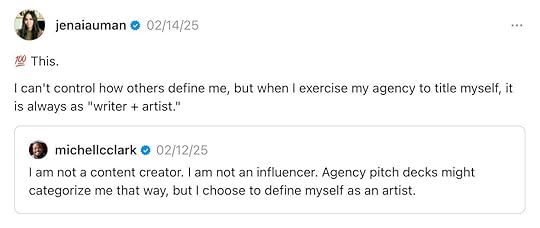
For me, being an artist is like putting on my favorite coat. For those who find the work meant for them, the fit is *just right*. The Goldilocks zone of vocations. From the likes of Michelangelo and, more specifically, creative women and female mystics who created a body of spiritual artwork and writing throughout church history, these stories reveal a subversive tradition. A rich heritage. One where others had fun, challenged those in power, and found moments of delight, too, even if a touch petty.
Michelangelo painted, but he considered himself a sculptor. My work often looks like content creation, but I consider myself an artist. I send words into the world with purpose because there are many words shared in the world without purpose. Or, worse, the words often sent out into the world are sent to harm. Like Mike, I resist and dissent against my own Biagios who hoot and holler while overly involved in policing the lives and work of others.
I dare to think that, in subverting the powers and principalities perpetuating injustice in the world, God blesses your shalom-fostering, truth-telling pettiness.
Staying Connected to ArtBecause I’ve identified as an artist, I occasionally get asked how being an artist is linked to my vocation as I do work in other spheres and arenas. How does art integrate with what Frederick Buechner would call the place where my “deep gladness and the world’s deep hunger meet”?5 How do I create when, in our current cultural moment, art is ill-valued in the world and hard to make a living off of.
Let me share a response I recently sent to a former writing mentee:
If you want to create art to share with the world, it’s helpful to understand your own connection to art. My personal connection is that I create because I’m a creator who was made to image my Creator. I don’t create because I am a “content creator.” I make art because I’m an artist; making art is a part of my holy alignment. It is a part of me staying integrated. Whole. The act of creation is a part of my healing. The desire or urge to create has everything to do with how I was created and who I was created to become. Shalom with myself and with God is staying in alignment with who God has made me to be. This is different, separate, and distinct from finding a sense of satisfaction based on how well-received my art is or isn’t.
Artists have historically been activists. They see the fractures formed from systemic injustices and are willing to exercise their imagination to dream about what wholeness could look like. The work of art is to help others see layers of truth—especially layers that are harder to receive and accept in other ways. So, artists are prophets, and prophets are usually not well-received by folks in power. Thus, pursuing art as a profession is hard for many.
So, my encouragement? Make art because you can’t not make art. Make art because it is like breathing—a part of who you are. And if you’re vulnerable and brave enough to put your art out in the world, you may find a community of folks who support you in your artistic endeavors.
A cautionary tale? Some artists become successful because, rather than boldly pointing to the truths within their culture, they pander to the dominating culture. Art that panders is propaganda. It is bad art. Madeleine L’Engle has a few words on this. In her book Walking on Water, she writes, “If it is bad art, it is bad religion, no matter how pious the subject.”6 Bad artists use piety to pander to the powerful. It’s how political leaders can use God’s name while looking nothing like the person of Jesus.
What is “good art”? Art that tells the truth. Good art is a part of the continuing revelation of truth. Emily Dickinson wrote, “Tell the truth but tell it slant.” This is an encouragement not to bend the truth, but to tell it from a new angle. Give the people something new to see. Highlight a long-ignored crack. Delight them. Surprise them. Challenge them. Be bold enough to disagree and be disagreed with. And like Michelangelo, be maliciously compliant when your own Biagio believes you are too much or not enough.
In the words of the inimitable James Baldwin, “Artists are here to disturb the peace. They have to disturb the peace. Otherwise, chaos.”
Our current cultural moment in the United States doesn’t change my work. Does the state of the U.S. make me mad? Livid? Absolutely. Opening the news is a choice to come face to face with more heartbreak. Peace as defined by those in power is a compliant, malformative sort of peace. It isn’t the shalom of God. My work didn’t change with the inauguration of a new U.S. president. The work is the same. My vocation is to foster wholeness. A holistic shalom. To do so, I know whose peace I need to disturb.
Fellow artists and creative activists: Create. Resist. Dissent. Subvert. Be offended. Find your petty.
Disturb faithfully. 🌾

 Updates
UpdatesSubstack is giving me the side-eye because “this post is getting too long for email.”
I’ll send a bonus post later this month on updates on the Courageous Women shirt and more info for those who leave reviews/ratings for Othered on Amazon.
1This comment on brothels was communicated to Michelangelo as a place of dishonor juxtaposed with the place of honor that was/is the Sistine Chapel. I, personally, hold more nuance than judgment for those engaged in sex work, particularly as it is widely understood as the oldest occupation women have turned to for survival. I do not intend personal judgment in this story, but I am aiming to stay true to what has been communicated to Michelangelo.
2I wanted to briefly note, I do not subscribe to Dante’s ideas of “hell.”
3I first learned of Michaelangelo’s The Last Judgment in a video I’ve since lost since my original deep dive into an art history wormhole, but I did my due diligence and found scholarly information on The Last Judgment written by Normal E. Land in “A Concise History of the Tale of Michelangelo and Biagio da Cesena,” (2013) found on JSTOR: https://www.jstor.org/stable/41955680. I have access through my seminary. If you would like to read but don’t have access, send me an email. I’m glad to share.
4Also a brief note, I’m not a Pope Paul III fan girlie, nor am I espousing what the Catholic Church was doing at this time. Abuses of ecclesial power made the construction of St. Peter’s Basilica possible in the first place. That is perhaps a post for another time.
5Frederick Buechner, Wishful Thinking: A Seeker’s ABCs (New York: HarperOne, 1993), 119.
6Madeleine L’Engle, Walking on Water: Reflections on Faith and Art (New York: Convergent Books, 2001), 4.
February 6, 2025
The Work of Justice Is to Soothe Aches
 Photo by Sam Mgrdichian on Unsplash
Photo by Sam Mgrdichian on UnsplashI published a book on othering in American Christianity in June 2024. Then, I disappeared.
Ok. I didn’t disappear, but I shrank back from public-facing online interactions to find a sliver of shalom.
Othered is a reader-supported publication. To receive new posts and support my work, consider becoming a free or paid subscriber.
This was due (in part) to my own capacity—seminary, traveling, writing, teaching, etc.
Also, the second half of 2024 laid me out. I retreated to my corner of the world and was contented to rest to catch my breath again. By the time January 1st rolled around, I felt restored. Renewed. Refreshed. Resurrected.
And not a moment too soon because, if we’ve learned anything in the first month of 2025, it’s that resistance and making good trouble is going to be a part of our communal work for the next four years.

The cohort I lead with the PAX Fellowship covers Contemplative Activism and Spiritual Formation. Contemplative Activism is about being rooted and established in the presence of Divine Love. From the overflow of Love, I am able to do my part to bring shalom to a world at war. I spoke with my fellows recently about justice. Despite some cultural Christian leanings, God’s justice isn’t a cosmic cousin to karma. God’s justice is not simply retributive or vengeful. The Hebrew word often translated as justice in the Bible (mishpat, מִשְׁפָּט) is so much more expansive; it is erroneous to boil its meaning down to “vengeance.'“
Mishpat is restorative. God’s justice is the great equalizer, flattening power dynamics for the flourishing of all.
In Streams of Living Water, Richard Foster writes that three major themes of the “social justice tradition” of Christian faith are mishpat, hesed, and shalom.1 In Othered, I share plenty on the nature of God’s hesed and how it fosters shalom; we see this particularly in how God cares for those who have been hurt, harmed, and marginalized throughout Scripture. Mishpat/justice is also a part of God’s hesed in that justice fosters shalom, too.
Mishpat mends what injustice breaks. God’s justice restores. Renews. Refreshes. Resurrects.
In the words of the BibleProject, the work of justice is “courageously making other people’s problems my problems.”
The work of justice is to humble the proud but also lift up the countenance of the lowly. Justice is pursuing the folks on the margins, listening to their voices, and seeing their diversity not as threats, but as beauty to behold. Justice brings holistic, equitable treatment to those mistreated. Justice is inclusive as it brings folks into the fold.
As tempted as I am to fight the folks leading the current administration of the United States, justice is more than swinging swords.
The work of justice is to soothe aches. The work of justice is to dismantle the systems that make us ache.
I will share with you what I shared with my PAX fellows: Every single system in our society is fractured. Education. Immigration. Healthcare. Family Systems. Municipalities. You name it. The world and the systems we’ve created to run it do not work as God originally intended. Repairing the fractures is the upward call of Jesus.2 Retreating to mend the wounds within us and reengaging to help mend the wounds of the world is the work of resurrection.
But the responsibility to repair the entire system is not on the shoulders of one individual. Repairing the fractures is a communal responsibility. You do not have to do everything, but we all have the capacity to do something.
Call your government officials. Connect with nonprofits who are doing the work of justice in the United States. Print and share red cards; learn how to keep your immigrant neighbors safe. (And if you know of other nonprofits doing good work, share in the comments!)
Love your neighbor as yourself. And, if you have the internal space for it, love your enemies, too.
Love others by embodying justice.
Let me leave you with the poem I wrote and shared on November 6, 2024.
jenaiaumanBecome safe people,
and find your safe people.
Mutuality and reciprocity.
Create refuges.
Foster compassion.
Build oases in dry places.
Gather goodness.
Sow hope.
Mourn the darkness
Gaining ground.
Steel yourself,
But stay tender.
Weep tears—
Of grief and rage.
Find what burns within you.
Tend to it.
Give it oxygen.
Breathe life.
Stoke the fire.
Warm a cold world.
 A post shared by @jenaiauman
A post shared by @jenaiaumanListen to the embers that are burning within you. Consider the sort of person God has created you to be. Spiritual formation is the work of becoming and belonging. Who do you dream of becoming? Who are the folks surrounding you who are helping you become that person? Are they helping you become that person? Cast off the voice of shame and listen to the still small voice inside you stirring you onward toward tender action.
I’m with you and for you,

Thanks for reading Othered! This post is public so feel free to share it.
 Why Othered Exists
Why Othered ExistsI wrote Othered to be intersectional. This means I hoped to fill a gap in the literature.
Many folks believed there were no books on religious trauma and spiritual abuse until recently. The truth is books, stories, and writings on harm occurring within the Church have been around for centuries. However, we usually understand them as books on racism, sexism, patriarchy, and so on. We (woefully) keep older and ancient writings separated from the current books on spiritual trauma because of how we understand the context of our cultural moment.
Our cultural moment of abuse and harm is a repeated pattern in church history. Othering another human being is an act of dehumanization that makes abuse and harm possible.
I wrote Othered so that survivors like myself and others could grasp that the ways in which our leaders/communities dehumanized and discarded us is very similar to the ways in which faith leaders and communities have been dehumanizing and discarding human beings across time and space.
I’m hopeful enough to believe that Othered could play a small part in helping stop the cycle of harm in the church by helping people see the pattern. As I’ve learned and relearn from my friend Patty Taylor, when we know better, we do better.
A Gigantic FavorCould I ask you for a huge favor?
If you’ve read and appreciated Othered, would you mind leaving an Amazon review?
Folks have sent me DMs or emails about how much you appreciated the words I wrote. If you copied and pasted those words into an Amazon review, it would be helpful in getting the word out about Othered. Book promotion isn’t for the faint of heart, and getting the word out as a new and emerging author is like trying to shout in a thunder storm.
A rating and review would be a simple but huge help.
And for those who leave a review, I have a gift for you! Email me the link to your Amazon review, and I would LOVE to comp you a LIFETIME subscription as a paid subscriber to my Substack. This means that you would have access to all posts that I hide behind a paywall in the future (for whatever reason) without you having to pay monthly support.
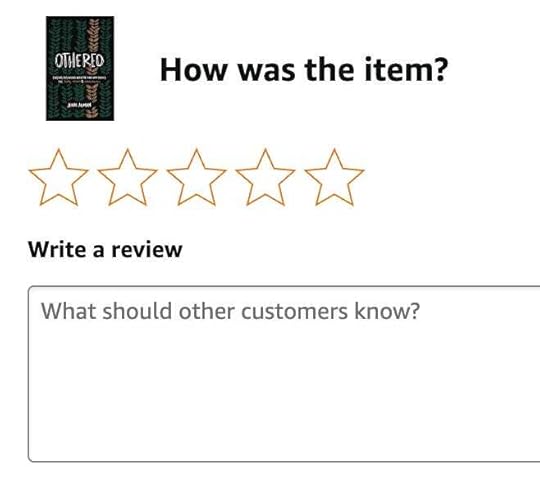
 Just For Fun
Just For FunI made a shirt!
I’ve kept my sanity the last few months by texting and laughing with friends (h/t to my very own Iron Squad). This shirt is the fruit of some of those conversations. We’ve chatted a lot about how women are often labelled witches or difficult just for taking up space and being leaders in the world. So, I created this COURAGEOUS WOMEN design just for fun on Bonfire.
I will be donating every dollar I make from the sale of these shirts to different nonprofits. I’ll keep everyone updated on where I make donations here on Substack. I hope to cycle through different nonprofits.
Get yours at https://www.bonfire.com/courageous-women/
If this post was helpful, considering tapping the heart 🖤 icon & leaving a comment. Your engagement helps me reach more people who may need a few words of hope. Encourage your friends to subscribe if you think the words here might be helpful to them.
You can find past posts from Othered by visiting jenaiauman.substack.com.
Have questions? Leave a Comment! (Click on that comment bubble at the bottom of the email!
1Richard J. Foster, Streams of Living Water: Celebrating the Great Traditions of Christ (New York: HarperOne, 1998), 167.
2Philippians 3:14
July 24, 2024
Providing Documentation When Writing a Story on Abuse of Power
 My copy of Othered with tags on pages that needed documentation and/or corroboration.
My copy of Othered with tags on pages that needed documentation and/or corroboration.My friend Katherine Spearing had me on the Uncertain Podcast to promote Othered. Before our interview, she messaged me about orienting our interview around a Substack post I wrote a few months back. She was interested on building on that particular post during our discussion together.
*You can read that former post here. ⬇️

Othered is a reader-supported publication. To receive new posts and support my work, consider becoming a free or paid subscriber.
The question from the above post was “How did you think through ways to avoid legal action when writing Othered?”
Because I had this question in mind, I wrote with extreme care. For one, Othered is not a memoir. Alas, there are some early reviews where readers expressed a wish that I included more of my story. There are also some reviews that believe I spilled too many beans. (And ones that say I didn’t tell the truth. 👀 More on that below.)
Second, I wrote from my perspective and what I witnessed and experienced, and, thus, I didn’t speculate on what other people in the story were thinking during many of the staff conflicts.
However, there are also checks in the publishing process. Let me share more.

On Katherine’s podcast, I speak a bit to what it was like to get the email about documentation and corroboration. An editor on the project contacted me. She wrote in part,
“When we have books dealing with church hurt and abusive behavior, our legal team reviews the relevant passages to make sure the author and publisher are protected from any unwanted accusations. Corroboration and/or some language revisions provide that protection.”
Thankfully, I kept screenshots, emails, and recorded video and audio files from my time on staff with the church and immediately after when my former pastors began their own internal “investigation”. The biggest pain was organizing all I had. I began recording conversations and meetings two years before I left my church. My documentation spans from 2018 to 2022. I also had a number of screen shots and emails. In short, I had a lot to filter through to corroborate the specific stories I shared in Othered. Had I shared more about my time on staff, I would have needed to provided more documentation. To organize what I needed, I created a “Corroboration” folder to provide the corroboration my publisher needed to bring Othered to print.

I also created a Google Sheet so they knew what document verified what specific claim within the final text of Othered. Each linked document opened to another file stored in my Corroboration folder.

(Above, you’ll see two page numbers. The first is the page number of the Word document I was addressing. The second page number is the page in the final text of Othered; I added this second page number for the sake of this post.)
There were also areas of Othered’s text where I had to change language. As Katherine and I discuss on the podcast, the need to change language does not mean that the noted instance didn’t occur or that it is made up. Changed language denotes that the author is writing from memory or recall. You typically see author notes on writing from memory or recall in the front of many memoirs. For instance, the below is a screen shot from the last chapter of the book where I added the phrase “From my point of view”.

In case you’re curious and have a copy of Othered handy, all instances of changed language in Othered are occur on the following pages:
p 18 - “What I recall hearing”
p 27 - “I remember”
p 51 - “I believe resided”
p 57 - “I recall”
p 62 - “I remember”
p 78 - “I remember” (You’ll see few of them on this page.)
p 116 - “What I believed to be a toxic environment”
p 136 - “I remember”
p 200 - “From my point of view”
Thank you for reading Othered. This post is public so feel free to share it.
You generally need to avoid writing direct quotes unless you have documentation of the direct quote. I did include a few direct quotes within Othered.
One direct quote is on page 77; this quote is from an email Tyler and I sent to our pastors. Another is on page 175; this quote is from a text message I received. The piece I directly quoted is underlined in yellow in the screenshot below.

I believe everyone who has experienced harm in the church deserves to have their story held and heard. However, if you choose to write you’re story for the public, having audio recordings, video recordings, and corroborating documentation will help protect you as you share.
If you’d like to hear more, check out my interview on the Uncertain Podcast with Katherine Spearing.

July 1, 2024
A Benediction: 🌾 OTHERED Book Club

There are new members of the OTHERED Book Club here! For any and all members, please feel free to go through previous BOOK CLUB posts and comments on any of the questions or thoughts you find there!
Sending you on your way…I loved closing Othered with the benediction from Numbers 6, but, following the late Eugene Peterson’s lead, I really preferred being…
June 25, 2024
OTHERED is everywhere books are 🌾

Othered releases today. 🌾
You can order Othered on Amazon, Barnes & Noble, Bookshop.org, + Baker Book House.
 Text within this block will maintain its original spacing when publishedThose who purchase Othered between Tuesday, June 25th to Monday, July 1st will still receive access to the free gifts. More info below. 💃
Text within this block will maintain its original spacing when publishedThose who purchase Othered between Tuesday, June 25th to Monday, July 1st will still receive access to the free gifts. More info below. 💃

I recently shared with someone that the weeks before book launch have felt like holding my breath—living in the inhale before the exhale of relief.
There’s not much more I could be doing to promote Othered, but I also feel like I could be doing everything. My body has cycled through excitement, anxiety, trepidation, and worry. From reading early reviews, Othered has been a balm for the brokenhearted (5 Stars ⭐️⭐️⭐️⭐️⭐️). I also read that the words I wrote are “arrogant, defensive, and completely unrelatable.” (3 Stars ⭐️⭐️⭐️). ¯\_(ツ)_/¯
I’m grateful to say that Othered has legs strong enough to walk out into the world and stand on its own.
This book is doing just what I hoped it would: Extending hope in God to those struggling to find their way, but also stirring up good trouble in spaces and communities where faithfulness has been equated with toxic conformity.
 Some of these images are my own. Some are courtesy of Charlotte G., Sarah Westfall, and Becky Castle Miller
Some of these images are my own. Some are courtesy of Charlotte G., Sarah Westfall, and Becky Castle MillerOthered is a reader-supported publication. To receive new posts and support my work, consider becoming a free or paid subscriber.
This book started by compiling notes I was writing in my notebooks. The case I make in Othered is comprised of all the arguments I couldn’t make to the pastors and leaders—brothers and friends—who othered me in my former church. Despite it’s name, I wrote Othered to unite us—to reveal that our wounds hold tremendous power to connect us. And if we don’t tend to our wounds, we run the risk of becoming people who perpetuate othering.
I read through the draft of the book proposal for Othered recently. Reading the section of what this book would and wouldn’t do was a very full circle moment for me. Take a peek:

When I submitted the proposal to publishers two years ago, I knew what I wanted this book to be and not be. Between myself, my editor (the wonderful ), and my team at Baker Books, I believe we hit the mark. I also want to give a special mention to Sara Shelton, who tapped in to help with developmental edits last summer.
This book isn’t for those who want to argue about whether or not abuse of power exists in the church. This book isn’t for those who want to other and denigrate the Church collectively. And this book isn’t for those who want me to argue for a new shade of religious fundamentalism.
This book is for the othered. It is for those who yearn for a life hemmed in with honesty, healing, and hope.
A tremendous thank you goes to you all who have helped me extend the hope I’ve been holding in my heart to others. Your encouragement and support have helped make this book possible.
Thank you for reading Othered. This post is public so feel free to share it.
 You can still download the free gifts through the first week of Othered’s release (yes, you have to buy the book first) 🌾
You can still download the free gifts through the first week of Othered’s release (yes, you have to buy the book first) 🌾

Fill out the form for FREE GIFTS
In case you’re interested: You can check out my Instagram Live video that recorded the day before launch.
jenaiauman A post shared by @jenaiauman
A post shared by @jenaiauman
 I swear, this is the last thing I’ll share…
I swear, this is the last thing I’ll share…I want to send special thanks to writers, friends, + writer friends who asked, “How can I help?” or reached out with tremendous kindness after I shared with them how hard the weeks leading up to Othered’s launch have been.
Substack is yelling at me about nearly being at the email limit, but you know who you are.
Thank you.
June 24, 2024
Week 6 🌾 OTHERED Book Club
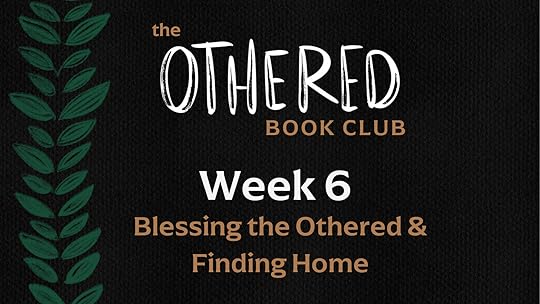 The Last GIVEAWAY 🎈 🎉
The Last GIVEAWAY 🎈 🎉 I’m going to be giving away another creative/spiritual direction ZOOM meeting this week!
To enter, all you’ll need to do is engage in the discussion of the comments of THIS POST. Leave comments that are substantive like answering some of the question prompts to the chapters below or respond to the posts of others!
Your name will be…



